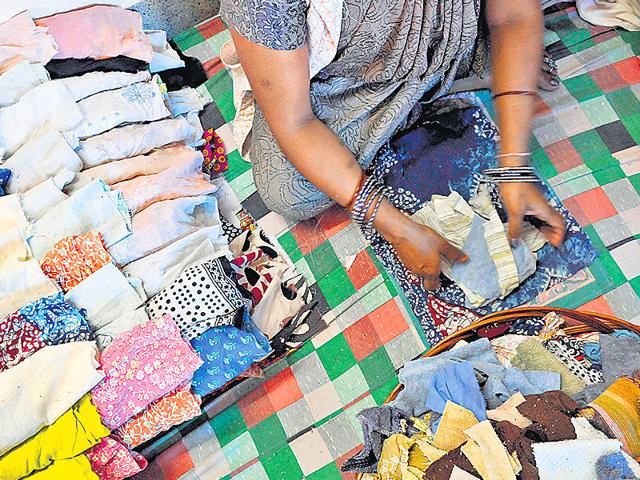 Editor’s note: Approx 125kg of sanitary waste is generated per person during their menstruating years and these sanitary napkins can take 500-800 years to break down! #ThePadEffect is a campaign to advocate for sustainable menstruation and prevent thousands of tons of sanitary waste.
Editor’s note: Approx 125kg of sanitary waste is generated per person during their menstruating years and these sanitary napkins can take 500-800 years to break down! #ThePadEffect is a campaign to advocate for sustainable menstruation and prevent thousands of tons of sanitary waste.Posted by Marcy Newman
Of all the things we throw “away” – to that imaginary place where it’s out of sight and out of mind – sanitary waste is likely the one we’d rather keep in that state of not knowing. Not knowing or thinking about what happens to it, and often not caring either. Such an attitude can only explain the number of women who flush their disposable sanitary napkins down the toilet, clogging drains and forcing sanitary workers to fish out the pad and remove the clog. Such an attitude also explains how approximately “432 million disposable sanitary napkins can wind up in landfills across India each year.”
Where is this magical place called “away” where all of our sanitary waste goes? And is it really so far away from us?
Whether it’s buried in the soil or dumped in a landfill or incinerated, it’s never far from us. The typical disposable sanitary napkin contains around 85% plastic (the remaining is typically wood pulp – not cotton though producers do a great deal to make us think otherwise) that’s used to absorb women’s blood in the top and bottom layer; manufacturers want that wood pulp to have the illusion of appearing to be cotton, so it is usually bleached and therefore contains toxic dioxins. And those are just the ingredients we can surmise as the MNCs who have pushed their products on women in India refuse to disclose the full list of toxic chemicals used in producing their pads. Thus the name “sanitary napkin” is a rather oxymoronic one; it is anything but.
Those dioxins seep into our soil, run off into our waters when buried or dumped, and are released into the air when incinerated. We grow our food in that soil, drink or bathe in that water, and breathe in that air. And plastic never degrades – it merely breaks down slowly with the help of the sun, over the course of a few thousand years. That means those smaller and smaller pieces can wind up in the stomachs of animals foraging for food – perhaps even when sitting in a bag on the street waiting to be picked up by a sanitation worker.
Burned plastics and chlorine bleach are especially toxic for women because it seeps into our tissue and have caused all sorts of health problems from endocrine disruption (mimicking oestrogen and creating hormonal problems) to reproductive disorders, cancer, and damage to the immune system.
That’s why there is no “away”. This toxic sludge is always with us whether it is visible or not. And because so much of it is not recyclable or biodegradable it will continue to have an impact on our daughters’ and granddaughters’ health for generations to come.
Even the so-called eco-friendly disposable menstrual pads that have emerged in the Indian market in the last few years continue to have a layer of plastic and seem to use chlorine bleach to give the appearance of hygiene like their MNC counterparts. Whether it’s deliberate greenwashing to establish a foothold in the marketplace or whether it’s sheer ignorance about chlorine’s dangers is unclear, but these products also fail to list the chemicals and ingredients that were used to produce them. And without any government oversight to insist that such labelling exists, the problem will persist.
Relying on the government – whether for oversight or support around menstrual and environmental health – seems to be a lost cause. They always seem to want an easy fix with the help of MNCs. Since 2010 the Ministry of Health and Family Welfare began subsidising disposable pads from MNCs for rural Indian women or the effort to put disposable pad vending machines in ladies’ restrooms or the most recent Swachh Bharat plan to incinerate sanitary waste, there is a consistent problem of choosing a quick fix.
These decisions have negative consequences for women’s health and for the planet’s health as well. Likewise, the recent Give Her 5 campaign to distribute disposable pads to schoolgirls to keep them from missing school during their periods is misguided because it teaches young girls that their health is tied to a culture of disposability even though it has impactful, long-term negative consequences on their health.
The only way out of this conundrum is to use cloth pads and to encourage others to do the same. Cloth pads are the only option that do not cause harm at any place in the production or usage cycle, including when finally disposed of. Cotton, while it may take years to break down, will biodegrade as it is plant based (aside from the small snaps and single layer of plastic lining to prevent leaks). There are so many brands to choose from in India today – from Uger to EcoFemme – that it is easy (not to mention economically feasible) to make the switch.
While many women attest to enjoying the freedom and comfort of the cup, at the end of the day it is still plastic and will likely line our landfills as women dispose of those after they run their course. So from a waste perspective, it’s not the most ideal choice. But a cloth pad is a part of a closed loop system like mother nature.
Ultimately, what’s missing from this conversation about menstrual hygiene and waste is the relationship between our bodies and planet’s body. As long as we dissociate the two it will be easier for us to imagine that there is a place called “away” where we can send our sanitary waste in whatever form that is and not let it worry us. But the truth is, whatever is good for the planet is good for us. If we want to have healthy bodies, we also have to invest in healthy soil, air, and water. Without this type of holistic approach, we won’t be able to have health for ourselves or future generations.
Marcy Newman is Outreach Lead at the Daily Dump in Bangalore and blogs at Teaching Trash. She is also an ambassador for EcoFemme.
Featured Image Credit: Goonj, Sarita Vihar centre | Saumya Khandelwal via HT Photo
About the author(s)
Guest Writers are writers who occasionally write on FII.




